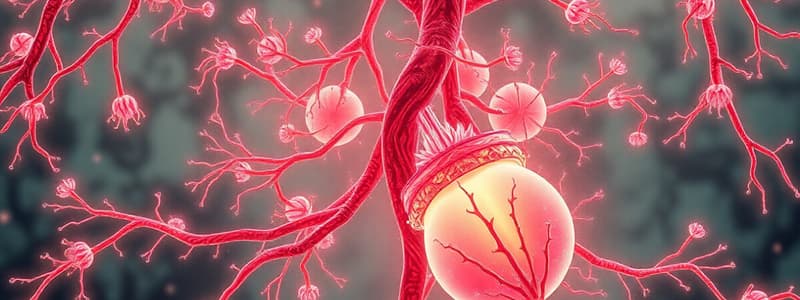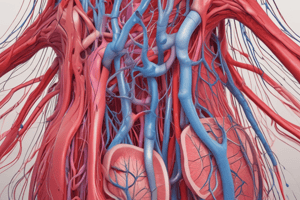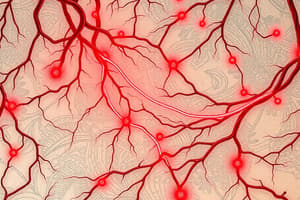Podcast
Questions and Answers
Which structure allows white blood cells to pass through capillaries?
Which structure allows white blood cells to pass through capillaries?
- Smooth muscle walls of the vessels
- High surface area from branching
- Narrow lumen decreasing passage size
- Spaces between the lining (endothelium) (correct)
What are the primary lymphatic organs responsible for?
What are the primary lymphatic organs responsible for?
- Activating immune responses
- Maintaining mature lymphocytes
- Filtering lymph fluid
- Producing lymphocytes from immature cells (correct)
How is lymph formed within the lymphatic capillaries?
How is lymph formed within the lymphatic capillaries?
- Through diffusion of proteins and bacteria
- Via filtration of lymphoid tissues
- From interstitial fluid entering capillaries (correct)
- By absorption of red blood cells
What is the primary function of the conducting system in the lymphatic system?
What is the primary function of the conducting system in the lymphatic system?
Which of the following best describes oedema?
Which of the following best describes oedema?
What distinguishes secondary lymphatic organs from primary ones?
What distinguishes secondary lymphatic organs from primary ones?
Which component is intentionally prevented from exiting lymphatic capillaries?
Which component is intentionally prevented from exiting lymphatic capillaries?
Which is NOT a role of lymphoid tissue?
Which is NOT a role of lymphoid tissue?
Flashcards
Capillaries
Capillaries
Tiny blood vessels that connect arteries and veins, facilitating exchange of gases, nutrients, and waste products between blood and tissues.
Tissue Fluid (Interstitial Fluid)
Tissue Fluid (Interstitial Fluid)
Fluid found in the spaces between cells, composed of water, dissolved nutrients, and waste products. It nourishes cells by providing nutrients from blood and removes waste.
Lymph
Lymph
Fluid that circulates in the lymphatic system. It's formed from tissue fluid and carries white blood cells, fats, and waste products.
Lymphatic System
Lymphatic System
Signup and view all the flashcards
Conducting System
Conducting System
Signup and view all the flashcards
Lymphoid Tissue
Lymphoid Tissue
Signup and view all the flashcards
Primary Lymphoid Organs
Primary Lymphoid Organs
Signup and view all the flashcards
Secondary Lymphoid Organs
Secondary Lymphoid Organs
Signup and view all the flashcards
Study Notes
Lymphatics
- Lymphatics is a system for fluid transport, consisting of capillaries, vessels, and nodes.
- Capillaries have thin walls, increasing the surface area for exchange.
- Capillaries' narrow lumen forces RBCs against the walls.
- Spaces between the capillary lining allow white blood cells to pass.
- Lymph is formed from tissue fluid (interstitial fluid).
- Tissue fluid is formed from blood plasma at the arterial end of capillaries.
- Lymph is then transported via lymphatic vessels.
- Lymphatic vessels transport lymph throughout the body.
Intended Learning Outcomes
- Describe the structure of a capillary and how it relates to its function. Key aspects include thin walls, large surface area for exchange, and narrow lumen.
- Describe interstitial fluid and how it's formed. Formation involves hydrostatic pressure forcing fluid from the capillaries.
- Describe how lymph is formed and its content. Lymph is formed when interstitial fluid enters lymphatic capillaries.
- Describe the lymphatic system (conducting system and lymphoid tissue). This includes the path lymph takes from capillaries to the venous system.
- Briefly describe the roles of primary and secondary lymphatic organs. This involves naming and identifying roles.
- Describe the structure of a lymphatic capillary. It includes the characteristics relevant to its function like blind-ended bulbous tubes to allow fluid entry and smooth muscles for unidirectional transport.
- Define oedema and describe two physiological situations associated with oedema. Oedema is swelling due to excess interstitial fluid. Examples include Elephantiasis (nematode worms in lymphatic vessels) and low plasma protein (Kwashiorkor).
Capillary Structure and Function
- Thin walls decrease diffusion distance
- Numerous/highly branched increases surface area for exchange
- Narrow lumen squashes RBCs against sides, reducing diffusion distance
- Spaces between the endothelial lining let white blood cells pass.
Capillary Microcirculation
- Blood flow moves into the capillary.
- Hydrostatic pressure forces fluid out.
- Osmotic pressure draws fluid back into the capillary from the interstitial fluid.
Lymphatic System- Conducting System and Lymphoid Tissue
- The lymphatic system's conducting system comprises lymphatic capillaries, vessels, and thoracic ducts. It collects fluid and returns it to the bloodstream.
- The conducting system collects lymph throughout the body and returns it to the venous system.
Lymphatic Capillaries
- Blind-ended, bulbous tubes.
- Endothelial cells form walls, allowing fluid/protein/bacteria entry but preventing exit.
- Collects fluid into lymphatic vessels.
- Contains unidirectional valves to prevent backflow.
Lymphoid Tissue
- Involved in immune responses, containing lymphocytes and other white blood cells within connective tissue.
- Tissues include tonsils, adenoids, lymph nodes, thymus, spleen, Peyer's patches, appendix, and bone marrow
- Lymphocytes and other cells are enmeshed in the connective tissue through which lymph passes.
Primary Lymphoid Organs
- Thymus and bone marrow
- Production of lymphocytes, early selection of lymphocytes
- Generate lymphocytes from immature cells
Secondary Lymphoid Organs
- Lymph nodes, spleen, Peyer's patches, tonsils (and adenoids)
- Maintain mature naïve lymphocytes, initiate an acquired immune response
- Sites of lymphocyte activation
Oedema
- Swelling due to excess interstitial fluid
- Caused by increased filtration exceeding lymphatic drainage or dysfunction.
- Causes include Elephantiasis (nematode worms in lymph vessels) and low plasma protein
Why Might Filtration Be Increased?
- Net water flow depends on balance between osmotic (related to protein content in capillary) and hydrostatic (artery/vein pressures) pressures.
Studying That Suits You
Use AI to generate personalized quizzes and flashcards to suit your learning preferences.
Related Documents
Description
This quiz explores the lymphatic system and the structure of capillaries. You will learn about the formation of tissue fluid, how lymph is transported through vessels, and the functional aspects of capillary anatomy. Test your understanding of these critical concepts in fluid transport and immune function.




